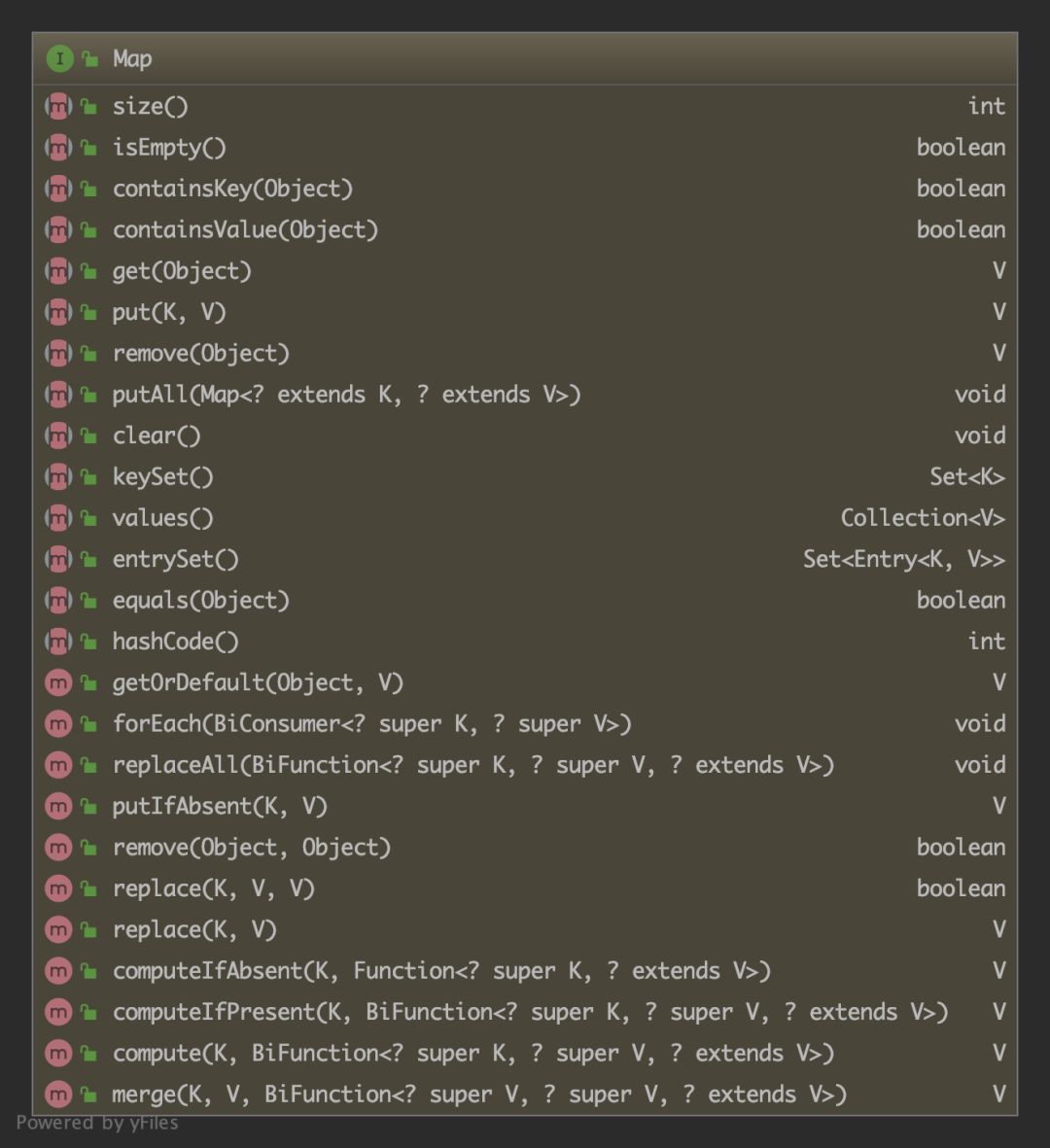JDK源码分析-Map
Posted WriteOnRead
tags:
篇首语:本文由小常识网(cha138.com)小编为大家整理,主要介绍了JDK源码分析-Map相关的知识,希望对你有一定的参考价值。
Map 接口
Map 是一个接口,它表示一种“键-值(key-value)”映射的对象(Entry),其中键是不重复的(值可以重复),且最多映射到一个值(可以理解为“映射”或者“字典”)。
Map 常用的实现类有 HashMap、TreeMap、ConcurrentHashMap、LinkedHashMap 等,它们的继承结构如下:
Map 的方法列表如下:

一些常用方法:
// 将键-值对存入 Map,若 key 对应的 value 已存在,则将其替换// 返回原先 key 对应的 value(若不存在,返回 null)V put(K key, V value);// 将指定 Map 中的所有元素拷贝到本 Map 中void putAll(Map<? extends K, ? extends V> m);// 返回本 Map 中所有 key 的 Set 视图Set<K> keySet();// 返回本 Map 中所有 value 的 Collection 视图Collection<V> values();// 返回本 Map 中所有 Entry 的 Set 视图// 其中 Entry 是 Map 内部的一个接口,可以理解为 Map 的“元数据”Set<Map.Entry<K, V>> entrySet();
此外,JDK 1.8 又增加了不少方法,如下:
// 获取 key 对应的 value,若 value 为 null,则返回 defaultValuedefault V getOrDefault(Object key, V defaultValue) {V v;return (((v = get(key)) != null) || containsKey(key))? v: defaultValue;}// 遍历 Map 中的元素default void forEach(BiConsumer<? super K, ? super V> action) {Objects.requireNonNull(action);for (Map.Entry<K, V> entry : entrySet()) {K k;V v;try {k = entry.getKey();v = entry.getValue();} catch(IllegalStateException ise) {// this usually means the entry is no longer in the map.throw new ConcurrentModificationException(ise);}action.accept(k, v);}}// 通过给定的函数计算出新的 Entry 替换所有旧的 Entrydefault void replaceAll(BiFunction<? super K, ? super V, ? extends V> function) {Objects.requireNonNull(function);for (Map.Entry<K, V> entry : entrySet()) {K k;V v;try {k = entry.getKey();v = entry.getValue();} catch(IllegalStateException ise) {// this usually means the entry is no longer in the map.throw new ConcurrentModificationException(ise);}// ise thrown from function is not a cme.v = function.apply(k, v);try {entry.setValue(v);} catch(IllegalStateException ise) {// this usually means the entry is no longer in the map.throw new ConcurrentModificationException(ise);}}}// 若 key 对应的 value 不存在,则把 key-value 存入 Map,否则无操作default V putIfAbsent(K key, V value) {V v = get(key);if (v == null) {v = put(key, value);}return v;}// 若 key 对应的值等于 value,则移除 key;否则无操作default boolean remove(Object key, Object value) {Object curValue = get(key);if (!Objects.equals(curValue, value) ||(curValue == null && !containsKey(key))) {return false;}remove(key);return true;}// 若 key 对应的值等于 oldValue,则将其替换为 newValue;否则无操作default boolean replace(K key, V oldValue, V newValue) {Object curValue = get(key);if (!Objects.equals(curValue, oldValue) ||(curValue == null && !containsKey(key))) {return false;}put(key, newValue);return true;}// Map 中存在 key 时,将 key-value 存入,相当于:/*if (map.containsKey(key)) {return map.put(key, value);} elsereturn null;}*/default V replace(K key, V value) {V curValue;if (((curValue = get(key)) != null) || containsKey(key)) {curValue = put(key, value);}return curValue;}// 当 key 对应的 value 不存在时,使用给定的函数计算得出 newValue// 并将 key-newValue 存入 Mapdefault V computeIfAbsent(K key,Function<? super K, ? extends V> mappingFunction) {Objects.requireNonNull(mappingFunction);V v;if ((v = get(key)) == null) {V newValue;if ((newValue = mappingFunction.apply(key)) != null) {put(key, newValue);return newValue;}}return v;}// 当 key 对应的 value 存在时,使用给定的函数计算得出 newValue,// 当 newValue 不为 null 时将 key-newValue 存入 Map;否则移除 keydefault V computeIfPresent(K key,BiFunction<? super K, ? super V, ? extends V> remappingFunction) {Objects.requireNonNull(remappingFunction);V oldValue;if ((oldValue = get(key)) != null) {V newValue = remappingFunction.apply(key, oldValue);if (newValue != null) {put(key, newValue);return newValue;} else {remove(key);return null;}} else {return null;}}// 根据 key 和其对应的 oldValue,使用给定的函数计算出 newValue// 若 newValue 为 null// 若 oldValue 不为空或 key 存在,则删除 key-oldValue// 否则无操作// 若 newValue 不为 null,用 newValue 替换 oldValuedefault V compute(K key,BiFunction<? super K, ? super V, ? extends V> remappingFunction) {Objects.requireNonNull(remappingFunction);V oldValue = get(key);V newValue = remappingFunction.apply(key, oldValue);if (newValue == null) {// delete mappingif (oldValue != null || containsKey(key)) {// something to removeremove(key);return null;} else {// nothing to do. Leave things as they were.return null;}} else {// add or replace old mappingput(key, newValue);return newValue;}}default V merge(K key, V value,BiFunction<? super V, ? super V, ? extends V> remappingFunction) {Objects.requireNonNull(remappingFunction);Objects.requireNonNull(value);V oldValue = get(key);V newValue = (oldValue == null) ? value :remappingFunction.apply(oldValue, value);if(newValue == null) {remove(key);} else {put(key, newValue);}return newValue;}
PS: 1.8 中的几个方法看似比较复杂,但有些方法实质上相当于对一些 if...else 语句的封装,利用 lambda 表达式可以让代码更简洁。
Entry 接口
Map 接口内部还定义了一个 Entry 接口(上面已经出现),它其实相当于 Map 内部存储的「元数据」,也就是 键-值(key-value) 映射。方法列表如下:
其中前面几个方法都比较简单,这里分析下后面几个 JDK 1.8 引入的方法,如下:
// 返回一个比较器,它以自然顺序比较 Entry 的 keypublic static <K extends Comparable<? super K>, V> Comparator<Map.Entry<K,V>> comparingByKey() {return (Comparator<Map.Entry<K, V>> & Serializable)(c1, c2) -> c1.getKey().compareTo(c2.getKey());}// 返回一个比较器,它以自然顺序比较 Entry 的 valuepublic static <K, V extends Comparable<? super V>> Comparator<Map.Entry<K,V>> comparingByValue() {return (Comparator<Map.Entry<K, V>> & Serializable)(c1, c2) -> c1.getValue().compareTo(c2.getValue());}// 返回一个比较器,它使用给定的 Comparator 比较 Entry 的 keypublic static <K, V> Comparator<Map.Entry<K, V>> comparingByKey(Comparator<? super K> cmp) {Objects.requireNonNull(cmp);return (Comparator<Map.Entry<K, V>> & Serializable)(c1, c2) -> cmp.compare(c1.getKey(), c2.getKey());}// 返回一个比较器,它使用给定的 Comparator 比较 Entry 的 valuepublic static <K, V> Comparator<Map.Entry<K, V>> comparingByValue(Comparator<? super V> cmp) {Objects.requireNonNull(cmp);return (Comparator<Map.Entry<K, V>> & Serializable)(c1, c2) -> cmp.compare(c1.getValue(), c2.getValue());}
小结
1. Map 接口虽然没有继承自 Collection 接口,但也是 JCF(Java Collections Framework) 的一部分;
2. Map 存储的是键-值(key-value)映射结构的对象;
3. Entry 接口定义在其内部,它是真正定义键-值映射的结构,相当于 Map 的「元数据」。
Stay hungry, stay foolish.
以上是关于JDK源码分析-Map的主要内容,如果未能解决你的问题,请参考以下文章